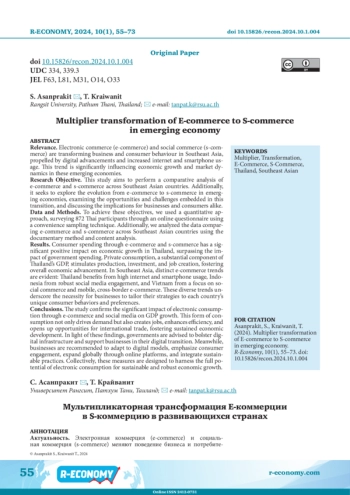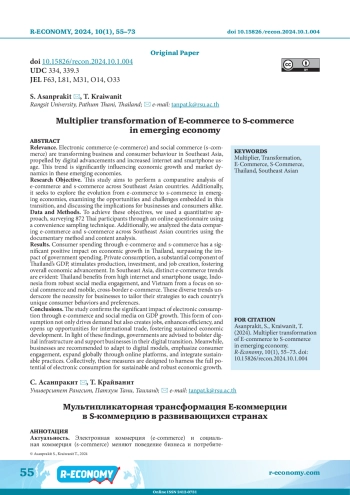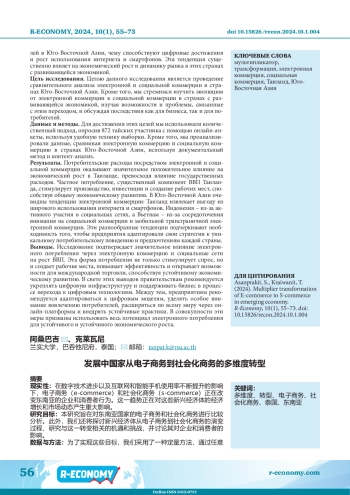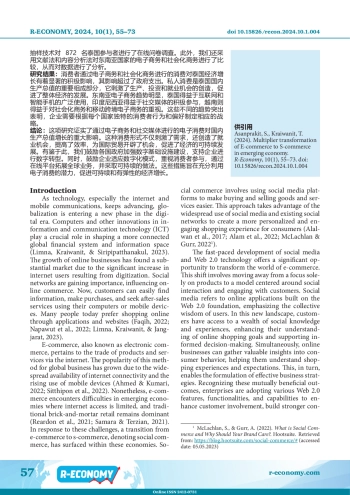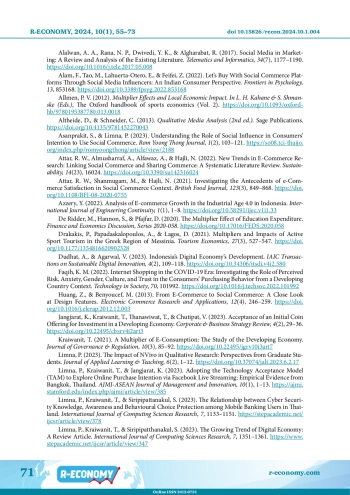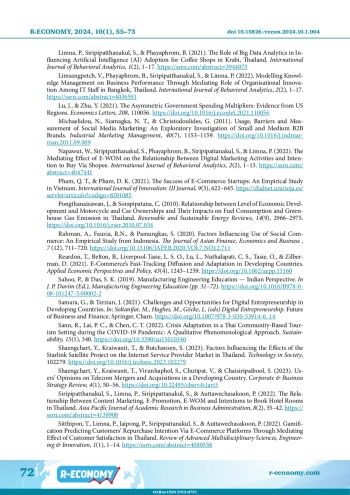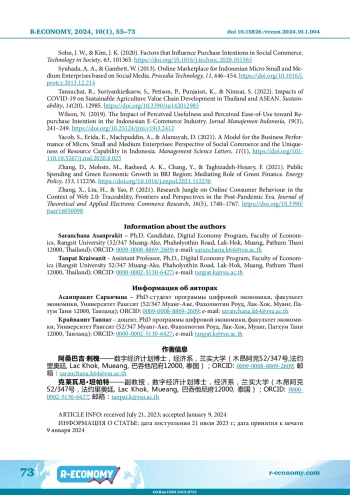Relevance. Electronic commerce (e-commerce) and social commerce (s-commerce) are transforming business and consumer behaviour in Southeast Asia, propelled by digital advancements and increased internet and smartphone usage. This trend is significantly influencing economic growth and market dynamics in these emerging economies. Research Objective. This study aims to perform a comparative analysis of e-commerce and s-commerce across Southeast Asian countries. Additionally, it seeks to explore the evolution from e-commerce to s-commerce in emerging economies, examining the opportunities and challenges embedded in this transition, and discussing the implications for businesses and consumers alike. Data and Methods. To achieve these objectives, we used a quantitative approach, surveying 872 Thai participants through an online questionnaire using a convenience sampling technique. Additionally, we analyzed the data comparing e-commerce and s-commerce across Southeast Asian countries using the documentary method and content analysis. Results. Consumer spending through e-commerce and s-commerce has a significant positive impact on economic growth in Thailand, surpassing the impact of government spending. Private consumption, a substantial component of Thailand’s GDP, stimulates production, investment, and job creation, fostering overall economic advancement. In Southeast Asia, distinct e-commerce trends are evident: Thailand benefits from high internet and smartphone usage, Indonesia from robust social media engagement, and Vietnam from a focus on social commerce and mobile, cross-border e-commerce. These diverse trends underscore the necessity for businesses to tailor their strategies to each country’s unique consumer behaviors and preferences. Conclusions. The study confirms the significant impact of electronic consumption through e-commerce and social media on GDP growth. This form of consumption not only drives demand but also creates jobs, enhances efficiency, and opens up opportunities for international trade, fostering sustained economic development. In light of these findings, governments are advised to bolster digital infrastructure and support businesses in their digital transition. Meanwhile, businesses are recommended to adapt to digital models, emphasize consumer engagement, expand globally through online platforms, and integrate sustainable practices. Collectively, these measures are designed to harness the full potential of electronic consumption for sustainable and robust economic growth.
Идентификаторы и классификаторы
As technology, especially the internet and mobile communications, keeps advancing, globalization is entering a new phase in the digital era. Computers and other innovations in information and communication technology (ICT) play a crucial role in shaping a more connected global financial system and information space (Limna, Kraiwanit, & Siripipatthanakul, 2023). The growth of online businesses has found a substantial market due to the significant increase in internet users resulting from digitization. Social networks are gaining importance, influencing online commerce. Now, customers can easily find information, make purchases, and seek after-sales services using their computers or mobile devices. Many people today prefer shopping online through applications and websites (Faqih, 2022; Napawut et al., 2022; Limna, Kraiwanit, & Jangjarat, 2023).
Список литературы
1. Ahmed N., Kumari A. (2022). The Implication of E-commerce Emerging Markets in Post-Covid Era. International Journal of Entrepreneurship and Business Management, 1(1), 21-31. DOI: 10.54099/ijebm.v1i1.102 EDN: VOTFOO
2. Alalwan A. A., Rana N. P., Dwivedi Y. K., Algharabat R. (2017). Social Media in Marketing: A Review and Analysis of the Existing Literature. Telematics and Informatics, 34(7), 1177-1190. DOI: 10.1016/j.tele.2017.05.008
3. Alam F., Tao M., Lahuerta-Otero E., Feifei Z. (2022). Let’s Buy With Social Commerce Platforms Through Social Media Influencers: An Indian Consumer Perspective. Frontiers in Psychology, 13, 853168. DOI: 10.3389/fpsyg.2022.853168 EDN: UFABZI
4. Allmen P. V. (2012). Multiplier Effects and Local Economic Impact. In L. H. Kahane & S. Shmanske (Eds.), The Oxford handbook of sports economics (Vol. 2). DOI: 10.1093/oxfordhb/9780195387780.013.0018
5. Altheide D., Schneider C. (2013). Qualitative Media Analysis (2nd ed.). Sage Publications. DOI: 10.4135/9781452270043
6. Asanprakit S., Limna P. (2023). Understanding the Role of Social Influence in Consumers’ Intention to Use Social Commerce. Rom Yoong Thong Journal, 1(2), 103-121. https://so08.tci-thaijo.org/index.php/romyoongthong/article/view/2188.
7. Attar R. W., Almusharraf A., Alfawaz A., Hajli N. (2022). New Trends in E-Commerce Research: Linking Social Commerce and Sharing Commerce: A Systematic Literature Review. Sustainability, 14(23), 16024. DOI: 10.3390/su142316024 EDN: WQZHHL
8. Attar R. W., Shanmugam M., Hajli N. (2021). Investigating the Antecedents of e-Commerce Satisfaction in Social Commerce Context. British Food Journal, 123(3), 849-868. DOI: 10.1108/BFJ-08-2020-0755 EDN: QWDPJH
9. Azzery Y. (2022). Analysis of E-commerce Growth in the Industrial Age 4.0 in Indonesia. International Journal of Engineering Continuity, 1(1), 1-8. DOI: 10.58291/ijec.v1i1.33 EDN: VHGXAJ
10. De Ridder M., Hannon S., Pfajfar D. (2020). The Multiplier Effect of Education Expenditure. Finance and Economics Discussion, Series 2020-058. DOI: 10.17016/FEDS.2020.058 EDN: PAQZLN
11. Drakakis P., Papadaskalopoulos A., Lagos D. (2021). Multipliers and Impacts of Active Sport Tourism in the Greek Region of Messinia. Tourism Economics, 27(3), 527-547. DOI: 10.1177/1354816620902328 EDN: KWXOJG
12. Dudhat A., Agarwal V. (2023). Indonesia’s Digital Economy’s Development. IAIC Transactions on Sustainable Digital Innovation, 4(2), 109-118. DOI: 10.34306/itsdi.v4i2.580
13. Faqih K. M. (2022). Internet Shopping in the COVID-19 Era: Investigating the Role of Perceived Risk, Anxiety, Gender, Culture, and Trust in the Consumers’ Purchasing Behavior from a Developing Country Context. Technology in Society, 70, 101992. DOI: 10.1016/j.techsoc.2022.101992 EDN: PAIXWT
14. Huang Z., Benyoucef M. (2013). From E-Commerce to Social Commerce: A Close Look at Design Features. Electronic Commerce Research and Applications, 12(4), 246-259. DOI: 10.1016/j.elerap.2012.12.003
15. Jangjarat K., Kraiwanit T., Thanawiwat T., Chutipat V. (2023). Acceptance of an Initial Coin Offering for Investment in a Developing Economy. Corporate & Business Strategy Review, 4(2), 29-36. DOI: 10.22495/cbsrv4i2art3 EDN: EJIXUL
16. Kraiwanit T. (2021). A Multiplier of E-Consumption: The Study of the Developing Economy. Journal of Governance & Regulation, 10(3), 85-92. DOI: 10.22495/jgrv10i3art7 EDN: NFCVVI
17. Limna P. (2023). The Impact of NVivo in Qualitative Research: Perspectives from Graduate Students. Journal of Applied Learning & Teaching, 6(2), 1-12. DOI: 10.37074/jalt.2023.6.2.17 EDN: KEOUFX
18. Limna P., Kraiwanit T., Jangjarat K. (2023). Adopting the Technology Acceptance Model (TAM) to Explore Online Purchase Intention via Facebook Live Streaming: Empirical Evidence from Bangkok, Thailand. AJMI-ASEAN Journal of Management and Innovation, 10(1), 1-13. https://ajmi.stamford.edu/index.php/ajmi/article/view/385.
19. Limna P., Kraiwanit T., Siripipattanakul S. (2023). The Relationship between Cyber Security Knowledge, Awareness and Behavioural Choice Protection among Mobile Banking Users in Thailand. International Journal of Computing Sciences Research, 7, 1133-1151. https://stepacademic.net/ijcsr/article/view/378. EDN: IMIKII
20. Limna P., Kraiwanit T., Siripipatthanakul S. (2023). The Growing Trend of Digital Economy: A Review Article. International Journal of Computing Sciences Research, 7, 1351-1361. https://www.stepacademic.net/ijcsr/article/view/347. EDN: QHHLKU
21. Limna P., Siripipatthanakul S., Phayaphrom B. (2021). The Role of Big Data Analytics in Influencing Artificial Intelligence (AI) Adoption for Coffee Shops in Krabi, Thailand. International Journal of Behavioral Analytics, 1(2), 1-17. https://ssrn.com/abstract=3944075.
22. Limsangpetch V., Phayaphrom B., Siripipatthanakul S., Limna P. (2022). Modelling Knowledge Management on Business Performance Through Mediating Role of Organisational Innovation Among IT Staff in Bangkok, Thailand. International Journal of Behavioral Analytics, 2(2), 1-17. https://ssrn.com/abstract=4036591.
23. Lu J., Zhu Y. (2021). The Asymmetric Government Spending Multipliers: Evidence from US Regions. Economics Letters, 208, 110056. DOI: 10.1016/j.econlet.2021.110056 EDN: ZIADSB
24. Michaelidou N., Siamagka N. T., Christodoulides G. (2011). Usage, Barriers and Measurement of Social Media Marketing: An Exploratory Investigation of Small and Medium B2B Brands. Industrial Marketing Management, 40(7), 1153-1159. DOI: 10.1016/j.indmarman.2011.09.009
25. Napawut W., Siripipatthanakul S., Phayaphrom B., Siripipattanakul S., Limna P. (2022). The Mediating Effect of E-WOM on the Relationship Between Digital Marketing Activities and Intention to Buy Via Shopee. International Journal of Behavioral Analytics, 2(2), 1-13. https://ssrn.com/abstract=4047441.
26. Pham Q. T., Pham D. K. (2021). The Success of E-Commerce Startups: An Empirical Study in Vietnam. International Journal of Innovation: IJI Journal, 9(3), 622-645. https://dialnet.unirioja.es/servlet/articulo?codigo=8201085.
27. Pongthanaisawan J., Sorapipatana C. (2010). Relationship between Level of Economic Development and Motorcycle and Car Ownerships and Their Impacts on Fuel Consumption and Greenhouse Gas Emission in Thailand. Renewable and Sustainable Energy Reviews, 14(9), 2966-2975. DOI: 10.1016/j.rser.2010.07.034
28. Rahman A., Fauzia R. N., Pamungkas S. (2020). Factors Influencing Use of Social Commerce: An Empirical Study from Indonesia. The Journal of Asian Finance, Economics and Business, 7 (12), 711-720. DOI: 10.13106/JAFEB.2020.VOL7.NO12.711 EDN: FAAHBV
29. Reardon T., Belton B., Liverpool-Tasie L. S. O., Lu L., Nuthalapati C. S., Tasie O., Zilberman D. (2021). E-Commerce’s Fast-Tracking Diffusion and Adaptation in Developing Countries. Applied Economic Perspectives and Policy, 43(4), 1243-1259. DOI: 10.1002/aepp.13160 EDN: XBAMIM
30. Sahoo P., Das S. K. (2019). Manufacturing Engineering Education - Indian Perspective. In J. P. Davim (Ed.), Manufacturing Engineering Education (pp. 31-72). DOI: 10.1016/B978-0-08-101247-5.00002-2
31. Samara G., Terzian J. (2021). Challenges and Opportunities for Digital Entrepreneurship in Developing Countries. In: Soltanifar, M., Hughes, M., Göcke, L. (eds) Digital Entrepreneurship. Future of Business and Finance. Springer, Cham. DOI: 10.1007/978-3-030-53914-6_14
32. Sann R., Lai P. C., Chen C. T. (2022). Crisis Adaptation in a Thai Community-Based Tourism Setting during the COVID-19 Pandemic: A Qualitative Phenomenological Approach. Sustainability, 15(1), 340. DOI: 10.3390/su15010340 EDN: NEQBSM
33. Shaengchart Y., Kraiwanit T., Butcharoen S. (2023). Factors Influencing the Effects of the Starlink Satellite Project on the Internet Service Provider Market in Thailand. Technology in Society, 102279. DOI: 10.1016/j.techsoc.2023.102279
34. Shaengchart Y., Kraiwanit T., Virunhaphol S., Chutipat V., Chaisiripaibool S. (2023). Users’ Opinions on Telecom Mergers and Acquisitions in a Developing Country. Corporate & Business Strategy Review, 4(1), 50-56. DOI: 10.22495/cbsrv4i1art5 EDN: ARKKKA
35. Siripipatthanakul S., Limna P., Siripipattanakul S., Auttawechasakoon P. (2022). The Relationship Between Content Marketing, E-Promotion, E-WOM and Intentions to Book Hotel Rooms in Thailand. Asia Pacific Journal of Academic Research in Business Administration, 8(2), 35-42. https://ssrn.com/abstract=4138908.
36. Sitthipon T., Limna P., Jaipong P., Siripipattanakul S., Auttawechasakoon P. (2022). Gamification Predicting Customers’ Repurchase Intention Via E-Commerce Platforms Through Mediating Effect of Customer Satisfaction in Thailand. Review of Advanced Multidisciplinary Sciences, Engineering & Innovation, 1(1), 1-14. https://ssrn.com/abstract=4080558.
37. Sohn J. W., Kim J. K. (2020). Factors that Influence Purchase Intentions in Social Commerce. Technology in Society, 63, 101365. DOI: 10.1016/j.techsoc.2020.101365 EDN: VBJUYH
38. Syuhada A. A., Gambett W. (2013). Online Marketplace for Indonesian Micro Small and Medium Enterprises based on Social Media. Procedia Technology, 11, 446-454. DOI: 10.1016/j.protcy.2013.12.214
39. Tansuchat R., Suriyankietkaew S., Petison P., Punjaisri K., Nimsai S. (2022). Impacts of COVID-19 on Sustainable Agriculture Value Chain Development in Thailand and ASEAN. Sustainability, 14(20), 12985. DOI: 10.3390/su142012985 EDN: PKZGCZ
40. Wilson N. (2019). The Impact of Perceived Usefulness and Perceived Ease-of-Use toward Repurchase Intention in the Indonesian E-Commerce Industry. Jurnal Manajemen Indonesia, 19(3), 241-249. DOI: 10.25124/jmi.v19i3.2412
41. Yacob S., Erida E., Machpuddin A., Alamsyah D. (2021). A Model for the Business Performance of Micro, Small and Medium Enterprises: Perspective of Social Commerce and the Uniqueness of Resource Capability in Indonesia. Management Science Letters, 11(1), 101-110. DOI: 10.5267/j.msl.2020.8.025 EDN: YGHEGO
42. Zhang D., Mohsin M., Rasheed A. K., Chang Y., Taghizadeh-Hesary F. (2021). Public Spending and Green Economic Growth in BRI Region: Mediating Role of Green Finance. Energy Policy, 153, 112256. DOI: 10.1016/j.enpol.2021.112256 EDN: VRHECA
43. Zhang X., Liu H., Yao P. (2021). Research Jungle on Online Consumer Behaviour in the Context of Web 2.0: Traceability, Frontiers and Perspectives in the Post-Pandemic Era. Journal of Theoretical and Applied Electronic Commerce Research, 16(5), 1740-1767. DOI: 10.3390/jtaer16050098 EDN: ZNGVXS
Выпуск
Другие статьи выпуска
Relevance. In Central Asia, growing economic and infrastructural challenges require urgent solutions and a shift from resource-dependent economies. Although each Central Asian country is following its own independent path, regional integration processes are crucial for enhancing competitiveness at both individual and regional levels. Research Objective. The study aims to conduct a comparative analysis of the competitiveness of Central Asian economies, identifying both their weaknesses and opportunities for sustainable development in the region. Data and Methods. The study relies on both secondary qualitative and quantitative data, drawing on international research on competitiveness and methodological provisions developed by the World Economic Forum. Identical indicators from the World Bank database are analyzed for an indirect assessment of the global competitiveness of Central Asian economies. Results. The study’s findings reveal varying levels of competitiveness among the economies in question. Kazakhstan and Uzbekistan, in particular, have shown progress in this sphere due to the availability of natural resources, economic reforms, investments in infrastructure, and the development of human capital. Conclusions. In order to improve the quality of life for their citizens, Central Asian countries need to enhance their competitiveness, which can be accomplished by implementing measures such as diversifying economies, strengthening institutions, and attracting investment in innovative projects.
Relevance. Strengthening fiscal decentralization is viewed as a crucial strategy to foster the economic development of Russian regions. Research Objective. The research aims to assess the potential impact of redistributing tax revenues, particularly VAT, among various budget levels. Data and Methods. The study employs regression analysis to investigate the correlation between the Gross Regional Product (GRP) of Russian regions and the expenditures of their consolidated budgets. A comparative analysis is also conducted, using data from the Federal Tax Service on VAT receipts to the federal budget and data from the Federal State Statistics Service on GRP and expenditure components of regional budgets from 2005 to 2021. Results. The research confirms the Russian government’s concerns regarding a possible increase in economic disparities if 40% of VAT is shifted to sub-federal levels. It reveals the negative impact that such a measure would have on specific regions. Instead, a more promising approach is to implement a special budgetary regime in select regions to stimulate their development. Conclusions. The study showcases adverse effects associated with transferring 40% of VAT to the sub-federal level. It proposes a mechanism to enhance fiscal decentralization in Russia, aiming to advance regional economic development, address economic disparities among regions, and offset any potential reduction in federal budget revenues.
Relevance. The unprecedented disruptions caused by the COVID-19 pandemic had a profound impact on the global economy, including Indonesia. Despite the challenges, Indonesia successfully managed to navigate and recover its international economic activities. Analyzing how Indonesia navigated its export advantages during the COVID-19 pandemic is crucial for understanding its resilience in the global economy. Research objective. The study aims to analyze the comparative and competitiveness of Indonesian export products, particularly the food processing industry, under the scheme of emerging markets and developing economies during the COVID-19 pandemic. Data and methods. This study relies on the data from Badan Pusat Statistik (BPS) and the Indonesian Ministry of Trade, along with world export data from the World Bank, OECD, and the International Trade Center, to examine the food processing industry during the 2021-2022 pandemic. Using the Revealed Comparative Advantage (RCA) model, it classifies comparative products for potential exports and diversification guidance. The Export Product Dynamics (EPD) model measures competitive advantage and serves as an early warning indicator, providing a comprehensive trade analysis for identifying growth opportunities and mitigating risks. Results. The RCA findings indicate that Indonesian processed food products for emerging market countries exhibit strong comparatives, supported by factors such as selling prices, production capacity, innovative technology, and trade tariff policies. This is reinforced by the results of the EPD analysis, which shows the dominance or rising star status of these products. Conclusions. The dominance of processed Indonesian food products points to the need for the government to uphold and expand exports beyond emerging market countries. Recommended measures include initiating revitalization, transformation, market analysis, and evaluating products categorized as falling stars or experiencing failures, missed opportunities, and retreats. Additionally, a focus on the upstream-downstream sectors of the food processing industry is crucial.
Relevance. The adoption of new technologies and the rapid emergence of innovation spur high-tech production and export-led economic growth. We aim to provide fresh evidence on the determinants of high-tech exports, considering different macroeconomic factors within the framework of the gravity model. Research Objective. The aim of the research is to empirically assess the impact of macroeconomic instability, tax policies, natural resources endowment, human capital, and institutional environment on the promotion of high-tech exports. Data and Methods. In considering the institutional indicator, six distinct indices from the World Bank are examined, and a common indicator is computed using principal component analysis. The econometric modeling uses a panel dataset covering the world’s 80 largest economies from 1996 to 2019. To test the assumptions of the gravity model and tackle the heteroscedasticity problem, the Poisson Pseudo Maximum Likelihood methodology is employed. Results. Higher inflation and unemployment rates are found to significantly decrease high-tech exports, while government external debt contributes to their enhancement. Tight tax policy and an increase in tax contribution are counterproductive in spurring high-tech exports. A negative and significant result is found for resource endowment, indicating that an increase in resource exports is counterproductive for technological advances and high-tech production. In most cases, the institutional environment and human capital significantly promote high-tech exports. Conclusions. Based on the presented empirical findings, we offer recommendations for the government to stimulate high-tech exports.
Relevance. In the pursuit of sustainable development, the circular economy takes precedence as a fundamental imperative for industrial transformation. The current trend in the development of the circular economy concept is to place the main focus on the technological support of circularization and the corresponding innovations in business models, while the decisive role people play in this model of economy is often overlooked. Individuals with specialized knowledge, skills, and values are essential for developing and implementing circular models, making effective management decisions, and promoting rational consumption patterns. The demand for circular skills and the availability of relevant competencies can significantly differ across regions, necessitating further in-depth study. Research objective. The paper is aimed at developing a new methodological approach to the study of circular economy skills at the regional level. This approach considers these skills in terms of both employer demand and their incorporation into master’s degree programs, accounting for regional specifics. Data and methods. The study employed a comprehensive approach, integrating theoretical methods with empirical analysis. Scientometric and content analysis identified taxonomies of circular economy skills, and employers’ personnel needs were examined through the analysis of the HeadHunter job site using Python software. Additionally, the study encompassed an analysis of educational programs from official websites of universities in southern Russian regions. Results. A new approach to the study of supply and demand of circular economy skills at the regional level has been proposed and tested. As a result, it was determined that there is a demand for sustainable development specialists in various industries in the Russian labor market, which varies across different regions of the country. The relevant skills are included in the master’s degree programs offered by universities. There is a need for greater involvement of regional authorities in shaping educational demands presented to universities, as this is essential for generating demand in the job market for the corresponding competencies. Conclusions. To better achieve targets in sustainable development and facilitate the transition to a circular economy, it is essential to promote a balanced development of all the relevant skills and behavioral patterns. To ensure this, it is important to involve regional authorities in shaping the demand for these skills.
Relevance. The development and implementation of advanced production technologies are the most important factors of economic growth and competitiveness in the modern economy. Predicting their dynamics, taking into account the spatial features of localization, is a difficult and time-consuming task. The spatial effects resulting from the impact of the surrounding territories play a significant role in the dynamics of advanced production technologies in the regions of Russia. Accounting for these effects is necessary when constructing scenario models in conditions of strong spatial heterogeneity of the studied processes. Traditional forecasting methods do not take into account spatial interdependencies and are not able to reflect the influence of surrounding regions on the development of technologies. Research objective. Assessment and scenario forecasting of the dynamics of advanced production technologies being developed in the regions of Russia using SAR models that allow taking into account spatial effects between regions. Data and methods. For scenario forecasting of the dynamics of advanced production technologies being developed in the Russian regions, taking into account spatial effects, a methodological approach was developed based on the modeling of the spatial log (SAR) of the processes of their development, autoregressive (ARMA) modeling and forecasting of the key factors of their dynamics. Taking into account spatial effects and heterogeneity, the proposed approach to modeling makes it possible to more accurately predict the dynamics of advanced production technologies in the Russian regions. Results. The developed methodological approach was tested to form predictive scenarios for the dynamics of advanced production technologies being developed in the regions of Russia. In particular, an inertial forecast scenario was developed, assuming the preservation of current trends in the dynamics of the technologies being developed, as well as two extreme possible scenarios - optimistic and pessimistic. With the help of the spatial SAR model, a significant influence of the number of research organizations on the volume of advanced production technologies generated was confirmed, and in the second group of regions, the influence of the number of technicians who conduct research and development was confirmed. The novelty of the study is to take into account the spatial features of the localization of the advanced production technologies being developed, as well as the spatial effects resulting from the impact of the surrounding regions on the creation of new technologies. This approach makes it possible to significantly reduce errors in the formation of forecast scenarios in conditions of significant spatial heterogeneity of the initial data. Conclusions. To intensify the generation of new technologies in the regions of the second group, it is necessary to attract personnel with technical specialties. The dynamics of the technologies being developed in the first group of regions with a powerful research potential are also influenced by the number of research personnel and the amount of attracted financial resources for fundamental and applied research. To increase the activity of these regions in the development of advanced technologies, it is necessary to form and develop relationships with the surrounding regions.
Статистика статьи
Статистика просмотров за 2025 год.
Издательство
- Издательство
- УрФУ
- Регион
- Россия, Екатеринбург
- Почтовый адрес
- 620002, Свердловская область, г. Екатеринбург, ул. Мира, д. 19
- Юр. адрес
- 620002, Свердловская область, г. Екатеринбург, ул. Мира, д. 19
- ФИО
- Кокшаров Виктор Анатольевич (Ректор)
- E-mail адрес
- rector@urfu.ru
- Контактный телефон
- +7 (343) 3754507
- Сайт
- https://urfu.ru/ru
